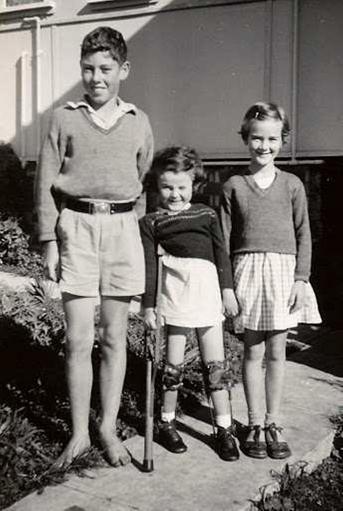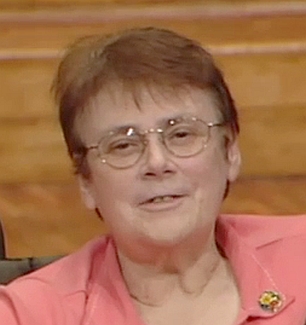Polio Survivor – Gillian from NSW
Gillian is a polio survivor living in NSW and is the President of Polio Australia and Polio NSW. The following is a presentation Gillian did at Parliament House on 10th March 2010 to launch the Parliamentary Friends of Polio Survivors.

To our Special Guest the Honourable Bill Shorten, our Parliamentary Friendship Group co-Convenors, the Honourable Greg Hunt and Mrs Jill Hall, other distinguished guests and friends of polio survivors and, of course, the polio survivors in this room, I’d like to take you back briefly to the 1950s.
The youngest child in this photo has obviously had polio. She contracted the paralytic form before she was 12 months old, some five years before the first polio vaccine was available in Australia. Of all polio infections, only 1% progress to the paralytic stage. In Australia up to 40,000 people were diagnosed with paralytic polio.
Her big sister, 3 years older, also contracted polio at the same time. She is counted in the 10% of polio survivors who were diagnosed with non-paralytic polio. She escaped seemingly unscathed after a relatively short hospital stay.
Their brother, another 3 years older, was never diagnosed with polio. However, studies have shown that when one child or more in a family is diagnosed with polio, the chances are very great that others in the family, particularly siblings, also contracted the disease. They are part of the silent majority of 90% of polio survivors in the Australian community today – many of whom never knew they had been infected by the polio virus.
After several years in hospital, the youngest child rejoined her family at home, learnt to walk with the aid of two full-length callipers and a walking stick, received a mainstream education at school and university, and joined the workforce in common with her non-disabled peers.
In this she wasn’t unique. Polio survivors were the first large group of people with disabilities who in the main were not institutionalised but got on with their lives after they recovered from the initial attack. Whether or not they had residual disabilities at that time, they went back to school, back to work, back to looking after families. They effectively disappeared back into society and many lost any links with their polio history. In addition, once the polio vaccines were available and new polio cases became virtually non-existent, the specialist Crippled Children’s Societies who had supported them diversified their operations. After all, polio was now a solved problem, wasn’t it? Unfortunately, what no-one knew then, was that the late effects of polio were poised to strike some 30 to 40 years later, and they would affect not only those diagnosed with paralytic or non-paralytic polio, but also a percentage of those unaware they had even contracted the disease.
By the late 1980s, this survivor of paralytic polio was approaching her fortieth birthday. She started experiencing symptoms such as unaccustomed fatigue, joint paint and muscle weakness. Strangely, some of her noticeably weaker muscles were those that she had always believed escaped the attack of the polio virus. Her siblings were also noticing some problems but did not yet associate them with their childhood brush with polio.
At this time there were no longer any health or disability services in place to support polio survivors. Fortunately for her and thousands like her, at around this same time, information about the late effects of polio was starting to filter into Australia from the USA, and grass roots support networks were being set up by polio survivors in each state. These networks gathered and disseminated information and provided support to fellow survivors and their families. The state networks started holding seminars, publishing newsletters and, over time, getting their message out via the internet. Although in the main totally under-resourced and run by volunteers who were themselves experiencing the late effects, the networks were nonetheless very successful in getting information out to polio survivors and reaching people previously hidden in the community.
Twenty years on, volunteers are still running the majority of the Networks, with little or no public funding. Victoria is the only state which today has any funded services for polio survivors. The other states desperately need similar services. Without federal involvement we fear this will never happen. Polio survivors form the largest group of people with disabilities in Australia today, yet they get the least support – in most states, health and disability support services for polio survivors are non-existent.
Over the next twenty or more years polio survivors will be putting an ever increasing strain on the health system if steps aren’t taken now to put comprehensive multi-disciplinary and specifically-targeted services in place. Under-resourced volunteers, particularly volunteers who are not only aging but experiencing increasing disability, can only do so much.
Polio Australia was formed by the state Networks in 2008 in particular recognition that the state Networks are under great stress and some are in danger of having to close their information and support services. Polio Australia is tasked with continuing the development and provision of quality and consistent information to health professionals, polio survivors and their families across Australia. Polio Australia’s business plan has initially identified a series of inter-related projects over a four year period to start to achieve its goals, and is grateful to our four Parliamentary Co-Patrons and to the Parliamentary Friends of Polio Survivors for supporting its vital work.
The challenges facing polio survivors have been virtually unchanged over the last twenty years:
- To have their symptoms recognised as being attributable to the late effects of polio.
- To be treated appropriately by knowledgeable health professionals.
- To be taught how to self-manage their chronic condition.
- To get the support required to stay living in the community, out of hospitals and nursing homes, and to continue as valued members of society.
Despite their achievements to date, the volunteer Networks are now reaching the end of their capacity. Polio Australia’s services will continue to take up these challenges on behalf of Australia’s tens of thousands of polio survivors, and they must be resourced to do so.





